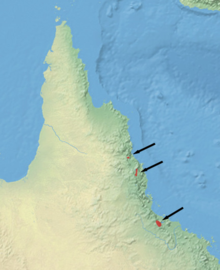Northern bettong
| Northern bettong[1] | |
|---|---|
| Scientific classification | |
| Kingdom: | |
| Phylum: | |
| Class: | |
| Infraclass: | |
| Order: | |
| Family: | |
| Genus: | |
| Species: | B. tropica
|
| Binomial name | |
| Bettongia tropica Wakefield, 1967
| |

| |
| Distribution of the northern bettong | |
The northern bettong (Bettongia tropica) is a small potoroid marsupial which is restricted to some areas of mixed open Eucalyptus woodlands and Allocasuarina forests bordering rainforests in far northeastern Queensland, Australia.
This bettong is a solitary animal and is nocturnal. It spends the day in a well concealed nest constructed beneath either a tree within a clump of grass or from other litter collected at ground level. Nesting material is carried using its prehensile tail. Ectomycorrhizal fungal sporocarps are the staple diet of the northern bettong. These are dug from beneath the soil at the bases of trees, and work to date suggests substantial nightly movements are often required to detect this patchily distributed food source. Other foods in the diet include grass roots and tubers, lilies, herbs, and sedges. The northern bettong appears to breed all year round, and like other relatives of the kangaroos, the joey is carried in a pouch until it is old enough to follow the mother as a 'young-at-foot'.
The northern bettong is an endangered animal, and only populates three regions of Queensland, Australia, all within 80 miles of each other.
References
- ^ Groves, C. P. (2005). Wilson, D. E.; Reeder, D. M. (eds.). Mammal Species of the World: A Taxonomic and Geographic Reference (3rd ed.). Baltimore: Johns Hopkins University Press. pp. 57–58. ISBN 0-801-88221-4. OCLC 62265494.
- ^ Template:IUCN2008 Database entry includes justification for why this species is listed as endangered
External links
- http://www.australianfauna.com/northernbettong.php
- http://www.jcu.edu.au/school/tbiol/zoology/auxillry/mammals/bettong.htm

